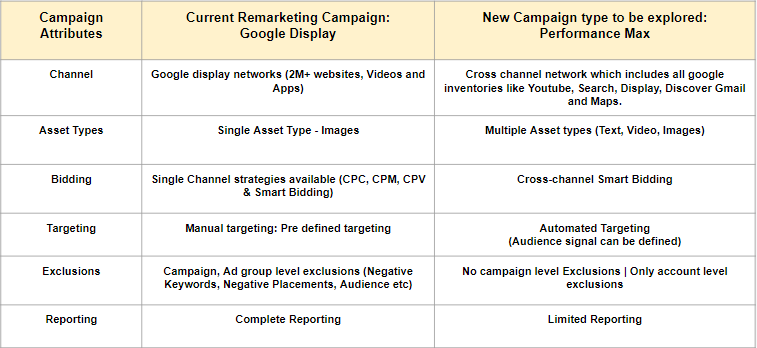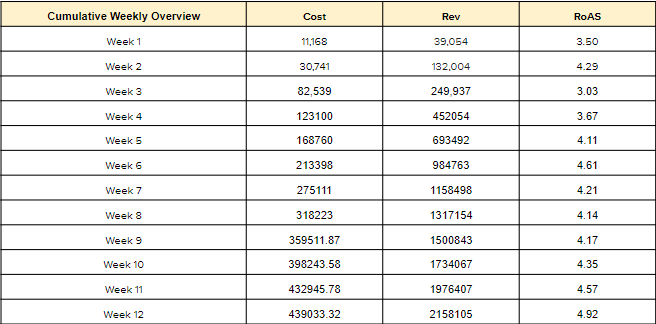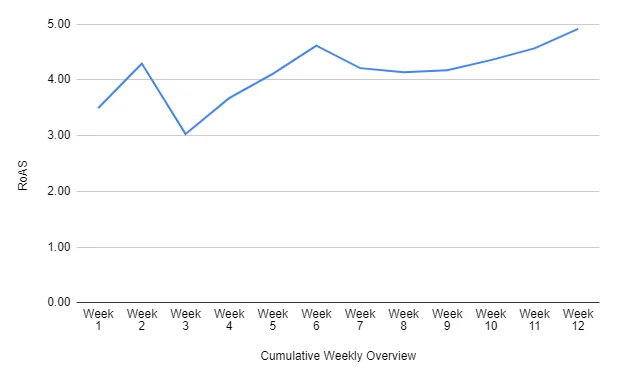5X ROAS GROWTH FOR A PAN-INDIAN COMPETITIVE EXAMS PREPARATION BRAND
Overview
Brand – A leading ed-tech platform that helps in competitive exam preparation through live classes, mock tests, interview prep and personal mentorship programs through both web and app-based learning.
Problem statement overview
- Ask: Nurture top-of-the-funnel users to purchase with the help of a Google remarketing campaign.
- Audience Considered: Past six Months’ users who completed the sign-up and did not take any action after signing up.
- Offering: Discount on the current pricing of the product/service.
- Audience Definition: We use Omni-channel engagement tools to bifurcate the audience based on user activity and directly push the audience list to the Google ads console.
- Volume of the audience: 5 – 8 Lakhs
Current Remarketing Campaign

Insights
No Potential revenue was seen on the campaign, Since the defined users are qualified audiences, the campaign was run with frequent optimizations over the period of Month –
Optimisations done on the campaign
- We identified irrelevant ad placements based on high impressions and excluded them from the campaign.
- We refreshed the ad creatives after 15 days since the campaign was not generating the expected revenue from the qualified audience even with the discount provided on the pricing.
Approach

Choosing the right campaign type
Verdict: The current display campaigns are not able to give the expected results despite the optimisations. Performance Max campaign is to be explored due to the dynamic nature of targeting the same user across all Google inventories, taking the defined audience list as signals and not restricting to reach a wider audience based on the signals defined.
Campaign Performance

Optimisations Done on Performance Max (PMAX) Campaign
- Started with a single generic campaign with multiple products as asset groups, and we identified the best-performing networks using a paid PPC analysis tool since the Google Ads Console reporting is very limited for performance Max.
- As PMAX turns on URL Expansion by default, we turned it off to send users to specific landing pages rather than letting Google decide.
- Disabling the Automatically created assets, which can start pushing the irrelevant combination of Ads.
- Refining the audience signals frequently based on cumulative revenue is important, as PMAX can reach new users based on the defined audience signals.
- Identifying the irrelevant ad placements and adding them to account-level placement exclusions.
- Creating strong brand exclusion lists, as it can start fetching the traffic from branded search queries, which will overlap the paid traffic and organic traffic.
- Changing the bid strategy from Maximise Conversions to Maximise Conversion Value right after the 21- 28 day range after the campaign’s revenue flow stabilised, to scale the conversion value in the right proportion.
Result

The effectiveness of the Performance Max campaign consistently outperformed the standard remarketing Display campaign.
Regular analysis of the campaign data and making necessary updates resulted in positive outcomes.
Success is contingent on continuous experimentation with creatives and messaging to ensure the delivery of the appropriate message to the right audience. Making strategic changes based on ongoing assessments is crucial for optimizing the campaign’s performance. The definition of audience segments plays a significant role in the success of a remarketing campaign.

